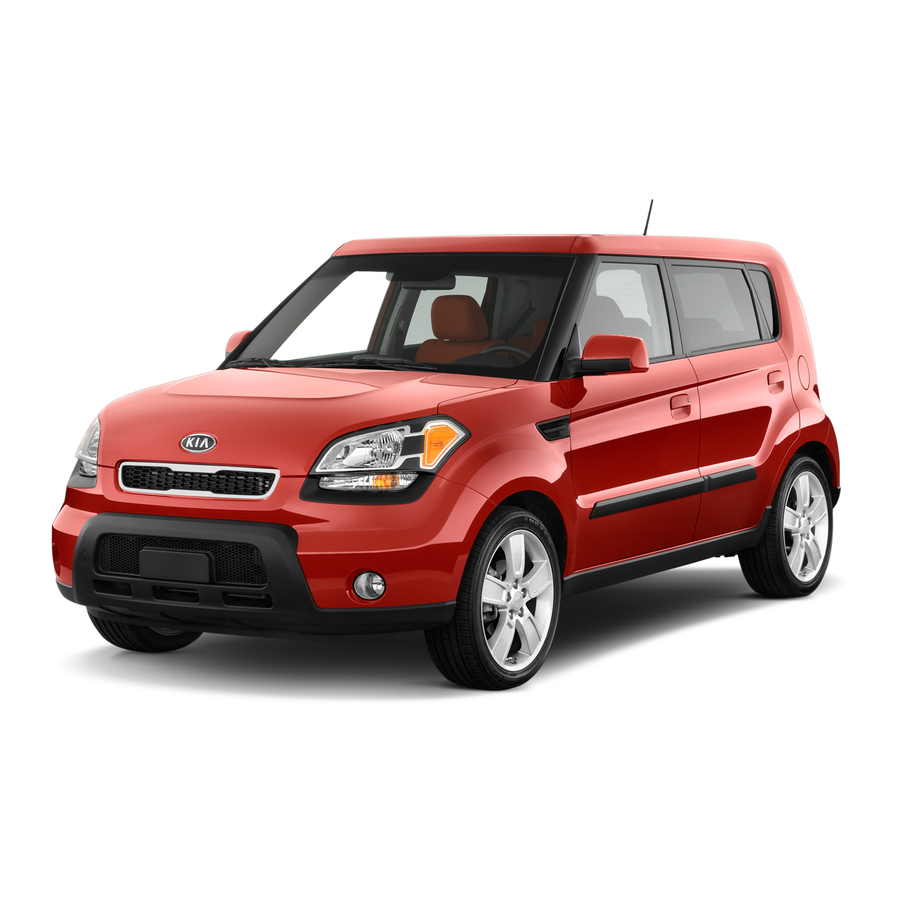
KIA Soul 2011 Manuals
Manuals and User Guides for KIA Soul 2011. We have 1 KIA Soul 2011 manual available for free PDF download: Owner's Manual
KIA Soul 2011 Owner's Manual (357 pages)
KIA Soul 2011
Brand: KIA
|
Category: Automobile
|
Size: 7.84 MB
Table of Contents
-
-
Seat Belts16
-
Seats16
-
-
Headrest18
-
Seat Warmer21
-
Seat Belts25
-
-
-
Door Locks85
-
Windows91
-
Sunroof99
-
Sunshade101
-
Power Steering103
-
Steering Wheel103
-
Tilt Steering103
-
Horn104
-
Gauges110
-
Speedometer110
-
Tachometer110
-
Fuel Gauge112
-
Odometer113
-
Trip Computer113
-
Tripmeter113
-
Tripmeter Mode114
-
Low Key Battery127
-
Insert Key128
-
Rearview Camera129
-
Lighting130
-
Lighting Control130
-
Front Fog Light132
-
Interior Light137
-
Map Lamp137
-
Room Lamp137
-
Mode Selection142
-
Air Conditioning145
-
Heating145
-
Ventilation145
-
-
Glove Box147
-
Air Intake153
-
Recirculated Air153
-
-
Luggage Box160
-
Multi Box160
-
Ashtray161
-
Cup Holder161
-
Power Outlet162
-
Sunvisor162
-
Clothes Hanger163
-
Roof Rack165
-
Antenna166
-
-
Audio System166
-
Radio Mode167
-
Seek/Preset167
-
Volume167
-
FM Reception169
-
Fading170
-
FM Radio Station170
-
Station Swapping170
-
Care of Discs172
-
SCAN Button174
-
Sdvc175
-
BALANCE Control176
-
FADER Control176
-
Preset Button176
-
CD Eject Button178
-
CD Loading Slot178
-
INFO Button178
-
REPEAT Button178
-
Phone Setup193
-
Pairing a Phone194
-
Deleting a Phone195
-
Advanced Menu196
-
Direct Calling197
-
Menu Tree197
-
Calling by Name198
-
Changing Name199
-
Deleting Name199
-
Key Matrix201
-
Before Driving204
-
Key Positions205
-
Lock Position205
-
ON Positon206
-
START Position206
-
ACC (Accessory)209
-
Start/Run210
-
Downshifting214
-
Using the Clutch214
-
P (Park)217
-
Transaxle Ranges217
-
D (Drive)218
-
N (Neutral)218
-
R (Reverse)218
-
Sports Mode219
-
-
Brake System223
-
Power Brakes223
-
Parking Brake224
-
Rear Drum Brakes224
-
ESC Operation229
-
ESC off Usage230
-
-
Driving at Night241
-
Smooth Cornering241
-
Highway Driving243
-
Snow Tires244
-
Winter Driving244
-
Trailer Towing246
-
Vehicle Weight251
-
-
Road Warning253
-
Jump Starting255
-
Push-Starting256
-
Jack and Tools268
-
Changing Tires269
-
Towing276
-
Emergency Towing278
-
Maintenance281
-
Fuse Box282
-
Radiator Cap282
-
-
At Least Monthly286
-
Chart Symbols290
-
Fuel Filter291
-
Coolant292
-
If Equipped292
-
Engine Oil294
-
Engine Coolant295
-
Air Cleaner303
-
Blade Inspection304
-
Reset Items309
-
Tire Care310
-
Tire Rotation312
-
Tire Replacement314
-
Tire Maintenance315
-
Tire Traction315
-
Radial-Ply Tires322
-
Summer Tires322
-
All Season Tires322
-
Fuses323
-
Memory Fuse325
-
Multi Fuse326
-
Inner Fuse Panel328
-
Appearance Care332
-
Exterior Care332
-
Washing332
-
Waxing333
-
Interior Care337
-
Canister339
-
Dimensions342
-
Bulb Wattage342
-
Engine Number347
-
Index348
-
Spare Tire354
Advertisement
Advertisement
